Why you should add captions to all your videos
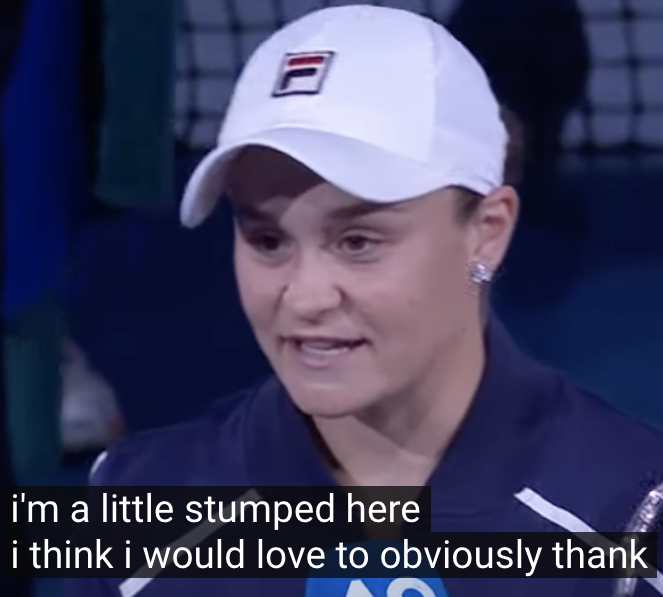

We’ve changed the way we are consuming video. That’s why you need to include captions or subtitles. Always.
The images above show Australian Open tennis champions Rafael Nadal and Ash Barty talking post match. It’s two famous athletes, usually captivatingly active, but now just static and talking.
You see this in your social feed and you’ve got 1.5 seconds before you scroll past. Your social feed is set to silent, so people in the meeting you’re in or Zoom call you’re on can’t hear that you’re distracted.
Without subtitles, most would keep scrolling. But with them, many of us would pause scrolling and be hooked in: Barty’s because it’s showing the vulnerability of being ‘stumped’ and probably about to say something warm and fuzzy about her family or partner, and Nadal’s with the great line about ‘the biggest comeback of my tennis career’.
We all love a story, but without the subtitles in these examples, there was no story for the “watching in silence” majority.
From accessibility to silent viewing necessity
Captions or subtitles on a video originally were to assist those with hearing difficulties, or to watch a foreign language film.
While accessibility alone is a powerful enough case for captions, now there’s additional and very compelling benefits to add them to all videos, as best practice.
And it applies to more than social video – in fact, it’s particularly applicable for organisations and any information-based videos for internal or external communications.
Here’s why.
For starters, as viewers, regardless of accessibility needs, we’re now used to seeing text with our video – from short clips on social media to a Netflix feature film.
If captions are there and we don’t want to read them, we unconsciously ignore them. But more likely, just as we’re used to being on two screens at once, our brains are also able to watch, listen and read everything on a video screen at the same time.
And statistics show that captions on videos boost viewing times, with more of us likely to watch all the way to the finish if there are captions.
Plus, captions improve comprehension of the video content, from message to entertainment.
Not to mention that increasingly we’re consuming our video silently, from auto-play on social feeds to silent environments where you’re viewing without headphones.
Most videos are watched silently. Words matter more than ever.
Between Facebook, Instagram and other content publishers, consensus is that up to 85 per cent of video viewing is with the sound off. And with the majority of viewers scrolling on their phones, you’ve got 1.5 seconds to grab their attention before they scroll past your video. An added benefit is Facebook records a ‘view’ for your video if you can hold someone’s attention for 3 seconds. In other words; at least temporarily delay their scrolling, even if they don’t watch the full video.
Other research showed increased viewer interaction for videos with captions, measured by shares and reactions. And in turn, most platforms’ algorithms reward shares, likes and clicks.
Here’s how a video looks, with and without captions, in a typical social feed for the 1.5 seconds of it’s opening screen before it’s scrolled past.

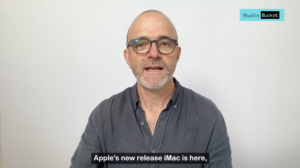
Now our review video on Apple’s latest iMac (we were gobsmacked by how good it’s inbuilt camera and microphone was for recording yourself) was unlikely to slow anyone scrolling past in the non-captioned version.
It’s just a guy talking to camera, with no clue as to the topic.
But the captioned version “Apple’s new release iMac is here” has the best chance of at least slowing the viewer’s scroll long enough to engage them in stopping for a full view – often still in silence, as the captions are giving them everything they require without the need for audio. Anyone with any interest in Apple products or the iMac in particular may now stop and watch, and then share with others they know may be interested.
In hindsight, we could have been more strategic with this opening to our video if we had taken captions and silent auto-play into consideration. Now because the main aim of our review was focussed on the new high quality webcam camera in the new iMac, we could have begun the video script instead with : “Apple’s new iMac now has a stunning camera, perfect for high quality video recording, Teams or Zoom.”
Adding the theme of ‘video recording’ plus referencing the ubiquitous Microsoft Teams and Zoom platforms would stand a higher chance of getting noticed in that brutal 1.5 second window.
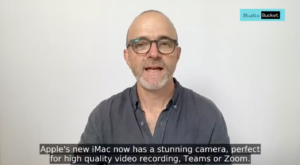
Whether they watch longer than 3 seconds is then up to the quality of the video content, or how relevant the theme is to them.
While this is primarily for social video, there are lessons for organisations who are increasing wanting to produce more videos for internal and external communications. Staff and stakeholders are most likely wanting the option of watching their work videos silently, on the bus, in a cafe, exercising on a treadmill, at home in bed or in the bathroom. Even if they aren’t consciously aware of the way they are now consuming a lot of their video content.
If you need to make your organisation more attractive for talent acquisition, engage them via video, with captions.
If one of your leadership team has an internal message to staff, a simple, authentic video recording with captions will do the job far more effectively than the usual email adding to inbox stress.
Finally, beyond adding captions for the benefit of your viewers, there’s also self-interest if your video is for public consumption.
Captions are Search Engine Optimisation (SEO) dynamite.
While this is not an issue for an organisation’s internal videos, it is a big deal if you are publishing your video externally and want to attract the largest audience. Those unsexy captions across the bottom of your video greatly increase your video’s chances of being discovered through a Google keyword search.
So when your website is being crawled by search bots sniffing for what your content themes are, you’re making it easier for them, and in turn giving your video the best chance to be ranked when someone types in a relevant keyword into their Google search.
Given the only downside to adding captions to your video is working out how to do it, followed by the time and cost involved, let’s review the process and options:
First, you need to transcribe your video. Artificial Intelligence (AI) speech to text, automated transcription used by Google (currently 60 minutes free per month then $US 24 cents per minute), YouTube and many transcription services like Temi ($US 25 cents per minute) are good, fast and cost effective – even if not yet perfect.
At $US 25 cents a minute, getting a transcript of a 45 minute video would cost $US11.25.
There are platforms that include transcription as part of a subscription, including our own Studio Bucket video project management platform, servicing Internal and External Communications, and Adobe’s Premiere Pro video editing software for the video editing pros.
As a rule, you can expect around 90-95 per cent accuracy depending on the quality of your original recording and how clear the spoken words are, how heavy the accent of the speaker and how many brand related terms, acronyms and other specialised language is used.
So second step is to correct the transcript. Ideally your organisation should have a style guide for language, grammar, whether you’re including ‘ums’ and ‘ahs’, and whether you include or edit colourful language or correct stumbles, mispronunciations or grammar.
Don’t underestimate the time it takes to run through your video transcript and correct it to be word perfect. Allow for 3-4 times the length of the video, so a 5 minute video will take 15-20 minutes to run through and correct the transcript so it’s 100 per cent accurate. For most brands, having accurate captions is a must have. You don’t want to be that brand that leaves the automated (and not corrected by a human!) captions up, and ends up going viral for the wrong reason, like when the Australian Capital Territory’s Chief Minister thanked the people of Canberra, or ‘Canberrans’ for their COVID lockdown compliance.
Courtesy of an automated transcription, the caption for ‘Canberrans’ instead read ‘Ken Behrans’ and was not corrected before the video was published. Soon Ken Behrans was trending and became a viral hit.

And then there was this well produced Australian Open tennis video, for their 700,000 subscribers on YouTube. Unfortunately it – along with women’s world number one and home grown star Ash Barty – were let down by unedited, automated captions, with the AI robot struggling with spelling and capitals to create this underwhelming result: “australia’s ash bhati is wimbledon champion”

Allow for captions in your video editing and design
There’s also a small video design element you should do when using captions. To avoid the captions clashing with any existing text on your video, raise that existing text high enough to run above the captions.
If your video involves people talking, this means at the very least you’ll likely have their name and title to run across the lower third of your video. Let your editor know you want the captions to have a clean run across the bottom, and you’d like any names and titles of speakers to be lifted above the captions.
Here’s an example of captions clashing with a name and title across the bottom, versus a design tweak in your video edit to push the name and title up to allow for the captions to fit under.
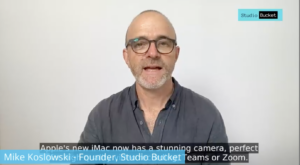
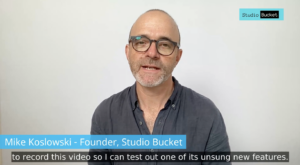
What are ‘burnt’ on or ‘baked on’ captions?
This is when your captions are permanently added to your video in the editing stage – the viewer cannot switch them off.
The advantages are that viewers watching on silent autoplay will instantly see the captions appear, you stand a higher chance of engaging them to watch more of your video than without captions instantly appearing, and the viewer doesn’t have to do anything to switch the captions on.
It’s also best practice for accessibility and engagement.
And for those with responsibility to publish the video, you don’t have to deal with uploading or messing around with any separate caption file – everything’s there on the actual video already.
Disadvantages are that it requires some design consideration for what’s appearing down the bottom of your video – in most cases just pushing up the name and title of any speaker to place it above the captions.
It could also annoy some viewers who are watching with audio and find the captions unnecessary.
What are ‘closed captions’?
Closed captions are when you provide the captions as optional for the viewer, who can manually select if they want the captions to appear.
This is usually by clicking a ‘CC’ icon below the video you are about to watch on YouTube or other platforms.

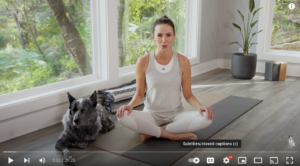
Advantages are they are optional, and each individual viewer can decide if they want them turned on or off. And if off, there’s no risk of clashing between the captions text across the bottom and any other elements of your existing video, so the visuals are cleaner.
Disadvantage is that if captions are off, and a viewer is watching in silence, there is a lower chance of engagement in the vital opening few seconds before they continue scrolling. Or if they would like captions, but don’t have the tech knowledge to know how to turn on the optional closed captions.
How do I create a closed caption file?
Once you have a transcript of your video that you have checked over and edited, you need to save it in a text file format that will be accepted and read by YouTube, Vimeo, OneDrive, Facebook, LinkedIn, Instagram and other publishing platforms. The two most common formats are an .srt file or .vtt file.
Then you would upload this text file separately to your publishing platform along with your video file.
The bottom line
Don’t overthink it. If you are serious about video, your audience and your brand, you need to add captions to your videos.
And it doesn’t take much to get them set up even for non technical users – AI transcriptions are done in one click, supplied in minutes, with accuracy improving all the time.
But for now, as the final step in your video creation and production process, no matter how simple the video, allow for that final check and text edit of your captions to avoid ash bharti and Ken Behrens.
Ash Barty, Canberrans and the rest of your audience will be grateful.
